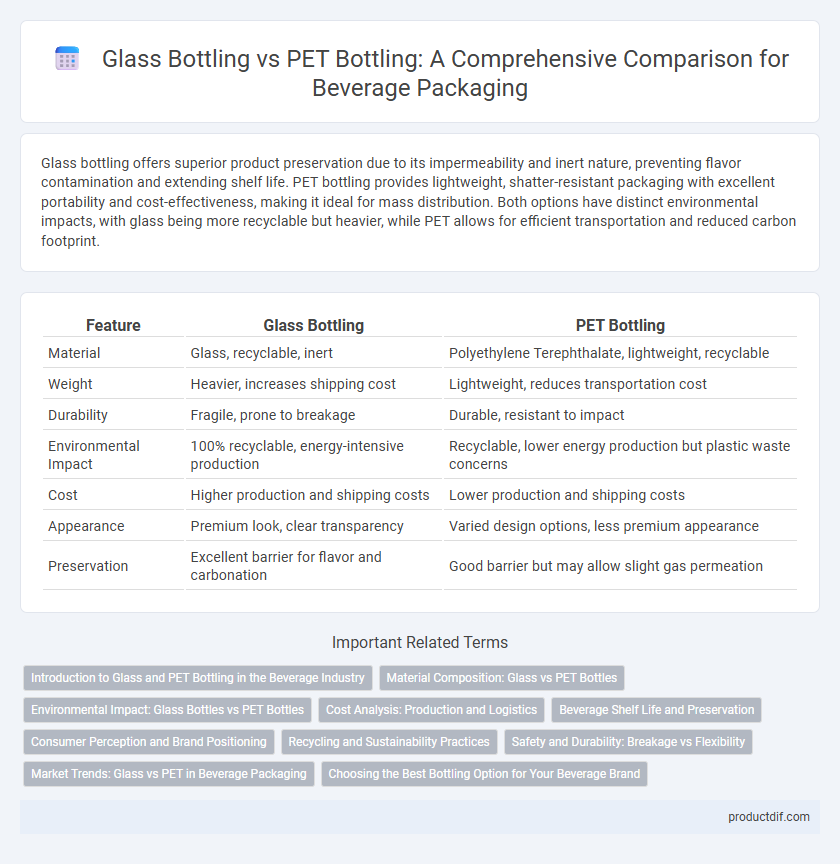Glass bottling offers superior product preservation due to its impermeability and inert nature, preventing flavor contamination and extending shelf life. PET bottling provides lightweight, shatter-resistant packaging with excellent portability and cost-effectiveness, making it ideal for mass distribution. Both options have distinct environmental impacts, with glass being more recyclable but heavier, while PET allows for efficient transportation and reduced carbon footprint.
Table of Comparison
| Feature | Glass Bottling | PET Bottling |
|---|---|---|
| Material | Glass, recyclable, inert | Polyethylene Terephthalate, lightweight, recyclable |
| Weight | Heavier, increases shipping cost | Lightweight, reduces transportation cost |
| Durability | Fragile, prone to breakage | Durable, resistant to impact |
| Environmental Impact | 100% recyclable, energy-intensive production | Recyclable, lower energy production but plastic waste concerns |
| Cost | Higher production and shipping costs | Lower production and shipping costs |
| Appearance | Premium look, clear transparency | Varied design options, less premium appearance |
| Preservation | Excellent barrier for flavor and carbonation | Good barrier but may allow slight gas permeation |
Introduction to Glass and PET Bottling in the Beverage Industry
Glass bottling offers superior product preservation and an inert surface ideal for maintaining beverage purity, widely favored for premium wines, spirits, and craft sodas. PET bottling provides lightweight, shatter-resistant containers with excellent recyclability and cost-efficiency, making it the dominant choice for carbonated soft drinks, water, and ready-to-drink products. Both materials impact supply chain dynamics, sustainability efforts, and consumer perception across the beverage industry.
Material Composition: Glass vs PET Bottles
Glass bottles are composed primarily of silica sand, soda ash, and limestone, offering excellent chemical stability and impermeability, which preserves beverage taste and carbonation effectively. PET bottles, made from polyethylene terephthalate derived from petroleum, provide lightweight durability and high impact resistance, suitable for a wide range of beverages including carbonated drinks. The recyclability of glass is highly efficient with infinite reuse potential, while PET recycling depends on collection systems but benefits from lower energy requirements during production and transportation due to its light weight.
Environmental Impact: Glass Bottles vs PET Bottles
Glass bottles are highly recyclable and can be reused multiple times without losing quality, significantly reducing environmental waste and energy consumption compared to PET bottles. PET bottles, made from petrochemicals, contribute to plastic pollution and often require lower energy to produce but pose challenges in biodegradability and recycling efficiency. Life cycle assessments highlight that glass has a higher carbon footprint during production, whereas PET bottles impact marine ecosystems and persist longer in landfills.
Cost Analysis: Production and Logistics
Glass bottling involves higher production costs due to raw material expenses and energy-intensive manufacturing, while PET bottling offers cost-efficient mass production with lower material and processing fees. Logistics costs for glass are elevated by heavier weight and fragility, increasing transportation and handling expenses, whereas PET bottles reduce shipping costs through lighter weight and enhanced durability. Companies balancing capital expenditure and supply chain efficiency often prefer PET for large-scale beverage distribution to optimize overall cost structure.
Beverage Shelf Life and Preservation
Glass bottling offers superior oxygen and moisture barrier properties, significantly extending beverage shelf life by preventing oxidation and preserving flavor integrity. PET bottling, while lightweight and shatter-resistant, allows minimal oxygen permeation that can reduce freshness and shelf stability over time. Advanced PET coatings and oxygen scavengers improve preservation but generally do not match the long-term shelf life provided by glass containers.
Consumer Perception and Brand Positioning
Glass bottling conveys a premium image, often associated with higher quality and better taste perception among consumers, enhancing brand prestige in the beverage market. PET bottling offers convenience and affordability, appealing to a broader audience while positioning the brand as practical and accessible. Choosing glass or PET impacts consumer perception and brand positioning by balancing luxury appeal against modern convenience.
Recycling and Sustainability Practices
Glass bottling offers superior recyclability due to its infinite reuse potential without quality loss, significantly reducing environmental impact compared to PET bottles, which degrade after multiple recycling cycles. PET bottling, though lightweight and energy-efficient during transportation, often faces challenges with contamination and limited recycling infrastructure, resulting in lower overall sustainability. Emphasizing closed-loop recycling systems and improving collection rates enhances the ecological benefits of both materials, but glass remains the preferred choice for sustainable beverage packaging.
Safety and Durability: Breakage vs Flexibility
Glass bottling offers superior safety through its inert, non-reactive properties, eliminating contamination risks, while its rigidity increases breakage potential during transport and handling. PET bottling excels in durability due to its flexible, shatter-resistant material, significantly reducing breakage incidents and ensuring product integrity in dynamic environments. The choice between glass and PET impacts safety protocols and cost-effectiveness, with glass prioritizing purity and PET focusing on resilience.
Market Trends: Glass vs PET in Beverage Packaging
The global beverage packaging market shows a dynamic shift between glass and PET bottling driven by sustainability concerns and consumer preferences. PET bottles dominate due to their lightweight, cost-effectiveness, and recyclability, capturing over 60% of the market share in carbonated soft drinks and bottled water segments. Glass packaging retains a premium niche in craft beverages and luxury products, benefiting from its recyclability and perceived quality despite higher production and transportation costs.
Choosing the Best Bottling Option for Your Beverage Brand
Glass bottling offers superior product preservation and premium appeal, ideal for high-end beverages seeking consumer trust through recyclability and taste integrity. PET bottling provides lightweight, cost-effective, and shatter-resistant packaging, optimizing logistics and shelf life for mass-market beverages. Evaluating target audience preferences, sustainability goals, and budget constraints is essential in selecting the best bottling option for your beverage brand.
Glass Bottling vs PET Bottling Infographic

 productdif.com
productdif.com